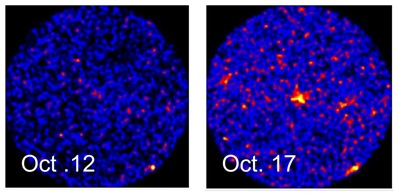
International Space Station experiment detects nova
DR EMILY BALDWIN
ASTRONOMY NOW
Posted: 26 October 2010


An X-ray detector on the International Space Station that alerted astronomers to a giant blast of X-rays, led to the discovery of a previously unseen nova.

Images of areas of 10 degrees in radius around the nova MAXI J1409-619, clearly seen on 17 October, but not in previous images. Image: JAXA/RIKEN/MAXI team.
The MAXI instrument, Monitor of All-Sky X-ray Image, on the Exposed Facility of the Japanese Experiment Module 'Kibo' recorded the initial blast, alerting a world wide observation campaign, including NASA's Swift Observatory, which slewed to the object nine hours later.
The Swift observations confirmed the object's presence as a previously unknown X-ray source lurking within our Milky Way in the constellation Centaurus. “The Swift observation suggests that this source is probably a neutron star or a black hole with a massive companion star located at a distance of a few tens of thousands of light years from Earth in the Milky Way,” says David Burrows, lead scientist for Swift’s X-ray Telescope.

Swift's detection of MAXI J1409-619. Image: MAXI/Swift team.
Nova result from the accretion of hydrogen onto a white dwarf star from a companion body, which subsequently ignites and causes runaway nuclear fusion. The enormous amount of energy liberated in this process causes bright outbursts, as likely occurred in the case of MAXI J1409-619 earlier this month.
“The collaboration between the MAXI and Swift teams allowed us to quickly and accurately identify this new object,” says Swift X-ray Telescope instrument scientist Jamie Kennea, at Penn State University. “MAXI and Swift’s abilities are uniquely complementary, and in this case have provided a discovery that would not have been possible without combining the knowledge obtained from both.”
|



